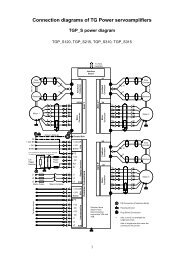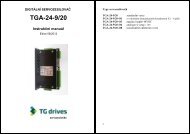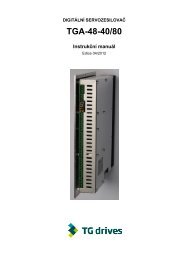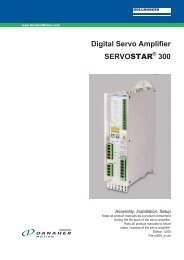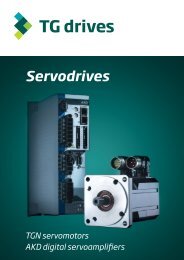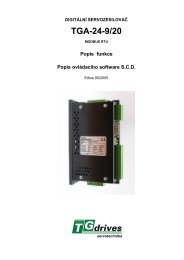Table of Contents - TG Drives
Table of Contents - TG Drives
Table of Contents - TG Drives
You also want an ePaper? Increase the reach of your titles
YUMPU automatically turns print PDFs into web optimized ePapers that Google loves.
140<br />
LAN1, Local area network 1<br />
LAN1, DOUBLE BUFFERING<br />
EXTENDED REGISTER GROUPS<br />
The firmware uses a double buffering method to communicate between the CAN<br />
lower protocol and the PL interpreter. The Read and Write instructions are used for<br />
manipulating the buffers.<br />
LAN1, SPECIFIC INSTRUCTIONS<br />
SetObjLAN1<br />
GetObjLAN1<br />
ReadLAN1<br />
,<br />
,<br />
<br />
This instruction will map a previously defined<br />
MsgObjLan1 to a , priority level, in the<br />
CAN low protocol, thereby activating the<br />
content <strong>of</strong> the MsgObjLAN1 (make it alive).<br />
Lower numbers yield higher priority.<br />
A MsgObjLAN1 is mapped to a priority level.<br />
The number <strong>of</strong> usable priority levels depends<br />
on the setting <strong>of</strong> LANx.lowprot as:<br />
Standard = 8 priority levels.<br />
Extended = 15 priority levels where level 15<br />
has special possibilities.<br />
Note. Priority level 13, 14 and 15 are reserved<br />
for system usage and may not be available in<br />
future releases.<br />
It is possible to remap an already activated<br />
object, just issue a new SetObjLAN1<br />
instruction with the same priority level.<br />
Example:<br />
<br />
...<br />
MsgObjLAN1.Id, 1234<br />
MsgObjLAN1.Type = 1 ; receive<br />
MsgObjLAN1.....<br />
...<br />
SetObjLAN1 1<br />
The Message Object with the ID 1234 is made<br />
active and mapped to priority level 1.<br />
For each message object received with ID<br />
1234 the content will be stored in the buffer<br />
related to priority level 1.<br />
To read the content into a register, the<br />
following code should be executed:<br />
ReadLAN1 r45, 4, 1<br />
This code is typically put into a interrupt<br />
service routine.<br />
Here is how to deactivate a message object:<br />
MsgObjLAN1.Type = 0<br />
SetObjLAN1 1<br />
A previous defined Message Object is<br />
deactivated.<br />
Fill in the MsgObjLAN1 with the message object at<br />
.<br />
Read bytes and put in register from the<br />
buffer for message object at .<br />
Multiple reads after the initial first, can be done by<br />
User's Manual 5.1 Inmotion Technologies AB<br />
Doc. No.9032 0027 01 (B), Rev. 11.07.2001




